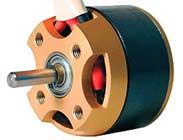
 Search Here
Search Here
MISC
Parts List
Robot Forum
Chat
Member Pages
Axon MCU
Robot Books
Shop
Contact
SKILLS
How To Build
A Robot
Tutorial
Calculators
Mechanics
Programming
Miscellaneous
Robots
Space
HARDWARE
Actuators
Batteries
Electronics
Materials
Microcontrollers
Sensors
SCIENCE
Robot Journals
Robot Theory
Conferences
- When buying a motor, consider stall and operating current (max and minimum)
- Stall Current - The current a motor requires when powered but held so that it does not rotate
- Operating Current - The current draw when a motor experiences zero resistance torque
- It is best to determine current curves relating voltage, current, and required torque for optimization
- When a motor experiences a change in torque (such as motor reversal) expect short lived current spikes
- Current spikes can be up to 2x the stall current, and can fry control circuitry if unprotected
- Use diodes to prevent reverse current to your circuitry
- Check power ratings of your circuitry and use heat sinks if needed
- Running motors close to stall current often, or reversing current often under high torque, can cause motors to melt
- Heat sink motors if not avoidable
- When buying a motor, consider stall and operating torque (max and minimum)
- Stall Torque - The torque a motor requires when powered but held so that it does not rotate
- Operating Torque - The torque a motor can apply when experiencing zero resistance torque
- Changing voltage will change torque
- Motors run most efficient at the highest possible speeds
- Gearing a motor allows the motor to run fast, yet have a slower output speed with much higher torque
- Remember that torque determines acceleration, so a fast robot with poor acceleration is really a slow robot
- If uncertain, favor torque over velocity
- Most efficient at rated voltage
- Motors run most efficient at the highest possible speeds
- Use gearing (opt to buy motors with built-in gearing or gear heads)
- Brushless motors MUST USE A SPECIAL CONTROLLER as it works through induction
- There are many different types of brushless DC motors. These motors can have from 2 to 4 poles for operation
- Encoder - device which counts rotations of wheel or motorshaft to determine velocity for a control feedback loop
- Tachometer - device which measures current draw of motor to control output torque

note: I have never actually used a brushless motor, so feel free to correct and verify this information
note: this page is a place holder until a better tutorial is written
What is a brushless motor? How is it different from a brushed motor? Brushless motors are more power efficient, and significantly reduced electrical noise, and last much longer. But they also have several disadvantages, such as higher prices and the requirement for a special brushless motor driver.
Voltage
Like all motors, the torque of a motor is highly dependent on the input voltage -
higher the voltage, higher the torque. Like all other motors, brushless motors also
run on an optimal voltage - check the datasheet. If you apply too high a voltage,
the coils could melt for all the heat, and if you apply too little voltage, torque
could be quite low.
Current
Power (Voltage x Current)
Torque
Velocity
Efficiency
Control Methods
Society of Robots copyright 2005-2014